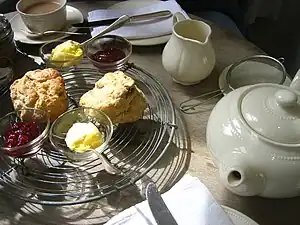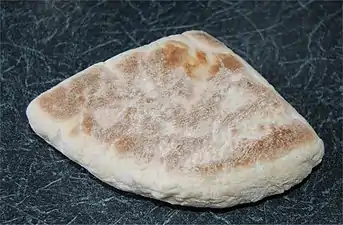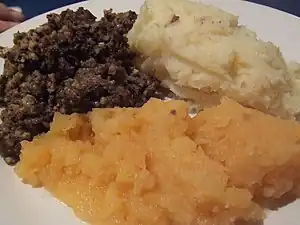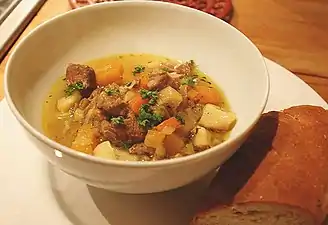British cuisine
British cuisine is the specific set of cooking traditions and practices associated with the United Kingdom, including the cuisines of England, Scotland, Wales and Northern Ireland. According to food writer Colin Spencer, historically, British cuisine meant "unfussy dishes made with quality local ingredients, matched with simple sauces to accentuate flavour, rather than disguise it".[1] International recognition of British cuisine was historically limited to the full breakfast and the Christmas dinner. However, Celtic agriculture and animal breeding produced a wide variety of foodstuffs for indigenous Celts. Wine and words such as beef and mutton were brought to Britain by the Normans[2] while Anglo-Saxon England developed meat and savoury herb stewing techniques before the practice became common in Europe. The Norman conquest introduced exotic spices into Great Britain in the Middle Ages.


| British cuisine |
|---|
| National cuisines |
| Regional cuisines |
| Overseas/Fusion cuisine |
| People |
|
|
|
| Part of a series on the |
| Culture of the United Kingdom |
|---|
 |
| Music |
The pub is an important aspect of British culture and cuisine, and is often the focal point of local communities. Referred to as their "local" by regulars, pubs are typically chosen for their proximity to home or work, the availability of a particular beer or ale or a good selection, good food, a social atmosphere, the presence of friends and acquaintances, and the availability of pub games such as darts or snooker. Pubs will often screen televised sports events. In recent years, some pubs have adapted to a culture in which fewer young people enjoy drinking alcohol or will not consume it in the same quantities as in the past.[3]
New foodstuffs have arrived over the millennia, from sausages in Roman times, and rice, sugar, oranges, and spices from Asia in the Middle Ages, to New World beans and potatoes in the Columbian exchange after 1492, and spicy curry sauces from India in the 18th and 19th centuries. Many vegetables seen today in British cuisine such as cabbage, peas, and cherries, were also brought as crops by the Romans.[4]
More recently, Indian cuisine has brought wide variety of food to Britain and was not only consumed in its native form, but was adapted to suit British tastes, dishes such as chicken tikka masala, balti dishes, kedgeree, mulligatawny soup and coronation chicken all took their inspiration from the food brought to Britain from India.
Traditional British dishes include full breakfast, roast dinner, fish and chips, toad in the hole and shepherd's pie. Traditional British desserts include trifle, scones, apple pie, sticky toffee pudding and Victoria sponge cake. Cheddar cheese also famously originated in the village of Cheddar in Somerset. Modern British cuisine has also been strongly influenced by other cuisines from around the world, and has in turn strongly influenced the cuisines of many other cultures around the world.
History
Beginnings
Bread from mixed cereal grains was first made around 3700 BC in Britain.[5]
Cider is an ancient British beverage. The first recorded reference to cider dates back to Julius Caesar’s first attempt to invade Britain in 55 BCE where he found the native Celts fermenting crabapples. He would take the discovery back through continental Europe with his retreating troops.[6]
In Roman times, further foods were introduced, such as sausages,[7][8] rabbit,[9] herbs and spices from further south in the Roman empire such as chives[10] and coriander,[11] and wine, which was produced in Britain in vineyards as far north as Northamptonshire and Lincolnshire.[12]
Prior to and after the Norman conquest of England in 1066, British food mostly consisted of vegetables, cereals and mutton.[13]
In the Middle Ages, the Anglo-Saxons introduced bacon to Britain sometime during the 1st millennium AD.[14] The Norman conquest reintroduced spices and continental influences into Great Britain in the Middle Ages;[15] oranges arrived in the late 13th century,[16] sugar cane in the 14th,[17] and carrots in the 15th century.[18]
Early modern to 19th century
With the Western exploration of the New World in 1492, the Columbian exchange led to the arrival in Europe of many new foods, including refined sugar, the potato, the banana[19] and chocolate. The growth in worldwide trade brought foods and beverages from the Old World too, including tea[20] and coffee.[21] Developments in plant breeding greatly increased the number of fruit and vegetable varieties.
The turkey was introduced to Britain in the 16th century,[22] but its use for Christmas dinner, with Christmas pudding for dessert, was a 19th-century innovation.[23][24] Other traditional British dishes, like fish and chips and the full breakfast, rose to prominence in the Victorian era;[25][26] while they have a status in British culture, they are not necessarily a large part of many people's diets.[27]
20th century
.jpg.webp)
During the World Wars of the 20th century difficulties of food supply were countered by measures such as rationing. Rationing continued for nearly ten years after the Second World War, and in some aspects was stricter than during wartime, so that a whole generation was raised without access to many previously common ingredients, possibly contributing to a decline of British cuisine.[28] Writing in the 1960s about British cuisine in the 1950s, the Good Food Guide called the food of the 1950s "intolerable" due to a shortage of real ingredients such as butter, cream or meat.[29] A hunger for cooking from abroad was satisfied by writers such as Elizabeth David, who from 1950 produced evocative books, starting with A Book of Mediterranean Food, whose ingredients were then often impossible to find in Britain.[30]
By the 1960s foreign holidays, and foreign-style restaurants in Britain, widened the popularity of foreign cuisine. This movement was assisted by celebrity chefs – on television and in their books – such as Fanny Cradock, Clement Freud, Robert Carrier, Keith Floyd, Gary Rhodes, Delia Smith, Gordon Ramsay, Ainsley Harriott, Nigella Lawson, Simon Hopkinson, Nigel Slater, Jamie Oliver.[30][31]
From the 1970s, the availability and range of good quality fresh products increased, and the British population became more willing to vary its diet. Modern British cooking draws on influences from Mediterranean (especially from Italian cuisine), and more recently, Middle Eastern and Asian cuisines. In the 1990s and early 2000s, a form of "virtuous eclecticism" emerged in discourse around British cuisine, arguing that British cuisine can be distinguished by its apparently unique ability to draw from other cultures.[29]
Furthermore, from the 1970s there was an increased push to recognise a distinctly British cuisine. The English Tourist Board campaigned for restaurants to include more British historical and regional dishes on their menus. In the 1980s, in the face of globalisation - which made foreign cuisines and imported produce more widely available in the UK - a style of cooking known as Modern British Cooking emerged in an effort to construct a national cuisine for the tourist industry. This new style of cooking focused on the garden and vegetables.[29]
Anglo-Indian cuisine
In the 18th and 19th centuries, the British Empire began to be influenced by India's elaborate food tradition with strong spices and herbs. Traditional British cuisine was modified with the addition of Indian-style spices and ingredients such as rice, creating dishes such as kedgeree (1790)[32] and mulligatawny soup (1791).[33][34]
Curry became popular in Britain by the 1970s, when some restaurants that originally catered mainly to Indians found their clientele diversifying.[35] Chicken tikka masala, a mildly spiced dish in a creamy sauce, was acclaimed "a true British national dish" as "a perfect illustration of the way Britain absorbs and adapts external influences".[36][37]
21st century
British culinary preferences have continued to evolve in the 21st century. Many people in a 2021 survey had never eaten such traditional favourites as toad in the hole, spotted dick, Scotch eggs, black pudding, or bubble and squeak, and a minority did not believe these dishes existed.[38]
In September 2022, Debora Robertson wrote in the Daily Telegraph that the 21st century has seen 'a revolution in British dining, fine and otherwise'.[39]
Characteristics
According to Warde, three definitions of British cuisine in response to globalisation predominate. Modern British Cooking draws on Britain's culinary history to create a new British traditional cuisine. Virtuous eclecticism highlights the melting pot of different national cuisines present in the UK. Another draws on popular, common products to produce a form of historical continuity between historical and modern cuisines.[29]
Internationally, British food tends to have a perception of being "terrible": bland, soggy, overcooked and visually unappealing.[40] The reason for this is debated. One popular reason is that British culinary traditions were strong before the mid-20th century, when British cuisine suffered due to wartime rationing.[40] A lot of myths about British food originate from this period.
Popular dishes
According to a survey by YouGov, the most popular British food is the Yorkshire pudding, which over 85% of Brits say they like, closely followed by Sunday roasts and fish and chips. The least popular was jellied eels, which only 6% of those who had tried it liked. Scones and Victoria sponge are the most popular sweet foods, while the Deep-fried Mars bar is the least popular.[41]
The Full English Breakfast was recently ranked number 1 in “The Most Popular British Dishes (Q3 2023)” by YouGov polls. With an 87% popularity rate, it is the national dish of the U.K. which is currently voted as most popular.[42]
Curries are a large part of British cuisine, with cooks in the United Kingdom creating curries distinct to the country. Chicken tikka masala, which comprises 15 per cent of orders in British Indian restaurants, was called "a true British national dish" by the Foreign Secretary Robin Cook in 2001.[43] Generally, British curries are thicker and sweeter than their Indian counterparts. Furthermore, curry sauces in Britain are interchangeable between meats, while in India different meats have non-interchangeable sauces.[44] A key ingredient to a British curry is curry powder, a "British concoction" of spices.[45]
National cuisines
English
English cuisine has distinctive attributes of its own, but also shares much with wider British cuisine, partly through the importation of ingredients and ideas from North America, China, and India during the time of the British Empire and as a result of post-war immigration. Some traditional meals, such as sausages, bread and cheese, roasted and stewed meats, meat and game pies, boiled vegetables and broths, and freshwater and saltwater fish have ancient origins. The 14th-century English cookbook, the Forme of Cury, contains recipes for these, and dates from the royal court of Richard II.[46]
Northern Irish
Northern Ireland's culinary heritage has its roots in the staple diet of generations of farming families—bread and potatoes.[47] Historically, limited availability of ingredients and low levels of immigration resulted in restricted variety and relative isolation from wider international culinary influences. The 21st century has seen significant improvements in local cuisine, characterised by an increase in the variety, quantity and quality of gastropubs and restaurants. There are currently three Michelin star restaurants in Northern Ireland, all of which specialise in traditional dishes made using local ingredients.[48]
Scottish
Scottish cuisine has closer links to Scandinavia and France than English cuisine has.[49] Traditional Scottish dishes include bannocks, brose, cullen skink, Dundee cake, haggis, marmalade, porridge, and Scotch broth.[49][50] The cuisines of the northern islands of Orkney and Shetland are distinctively different from that of mainland Scotland.[49] The nation is known for its whiskies.
Welsh
Welsh cuisine in the Middle Ages was limited in range; Gerald of Wales, chaplain to Henry II, wrote after an 1188 tour that "The whole population lives almost entirely on oats and the produce of their herds, milk, cheese and butter. You must not expect a variety of dishes from a Welsh kitchen, and there are no highly-seasoned titbits to whet your appetite."[51] The cuisine includes recipes for Welsh lamb, and dishes such as cawl, Welsh rarebit, laverbread, Welsh cakes, bara brith and Glamorgan sausage.[51]
- Example dishes of the four nations

 Northern Irish soda bread farl
Northern Irish soda bread farl
 Welsh cawl
Welsh cawl
International cuisines
The UK has had availability of a large variety of foreign cuisines since the post-war period. In 1970, the Good Food Guide stated: "London now has a richer variety of restaurants than any other city on Earth".[29] In 1995, the Good Food Guide argued that the fusion of national cuisines "could only happen here", as Britain is a melting pot without as distinct of a national cuisine as other such countries.[29]
See also
References
- Spencer, Colin (2003). British Food: An Extraordinary Thousand Years of History. New York City: Columbia University Press.
- Craig-Atkins, Elizabeth; Jervis, Ben; Cramp, Lucy; Hammann, Simon; Nederbragt, Alexandra J.; Nicholson, Elizabeth; Taylor, Allie Rae; Whelton, Helen; Madgwick, Richard (6 July 2020). "The dietary impact of the Norman Conquest: A multiproxy archaeological investigation of Oxford, UK". PLOS ONE. 15 (7): e0235005. Bibcode:2020PLoSO..1535005C. doi:10.1371/journal.pone.0235005. ISSN 1932-6203. PMC 7337355. PMID 32628680.
- "Alcohol-Free Options Grow In Popularity".
- Lipkowitz, Ina (5 July 2011). Words to Eat By: Five Foods and the Culinary History of the English Language. Macmillan. ISBN 978-1-4299-8739-4.
- ""Bread in Antiquity", Bakers' Federation website". Bakersfederation.org.uk. Archived from the original on 20 April 2010. Retrieved 3 June 2010.
- "History of Cider | WSU Cider | Washington State University". WSU Cider. Retrieved 6 September 2022.
- Davidson 2014, p. 717.
- Hickman, Martin (30 October 2006). "The secret life of the sausage: A great British institution". The Independent. Retrieved 15 April 2015.
- "archive Unearthing the ancestral rabbit", British Archaeology, Issue 86, January/February 2006
- "Chives", Steenbergs Organic Pepper & Spice Archived 11 December 2007 at the Wayback Machine
- ""Coriander", The Best Possible Taste". Thebestpossibletaste.co.uk. Archived from the original on 13 December 2010. Retrieved 3 June 2010.
- Keys, David (16 November 1999). "Veni, vidi, viticulture - remains of Roman vineyards found in UK". The Independent. Retrieved 17 September 2021.
- "Moveable Feast; British cuisine has admittedly had its indifferent times but these are history". The Times [London, England]. 7 July 2022. p. 25.
- "History Of Bacon". English Breakfast Society. Retrieved 19 September 2021.
- Spencer, Colin (2003). British Food: An Extraordinary Thousand Years of History. Columbia University Press. ISBN 978-0-231-13110-0.
- ""Food History Timeline", BBC/Open University". 18 November 2004. Archived from the original on 18 November 2004. Retrieved 3 June 2010.
- Lee, J.R. "Philippine Sugar and Environment", Trade Environment Database (TED) Case Studies, 1997
- "Stolarczyk, J. "Carrot History Part Two – A.D. 200 to date"". 3 March 2005. Archived from the original on 3 March 2005. Retrieved 3 June 2010.
- Forbes, K.A. "Bermuda's Flora" Archived 3 April 2007 at the Wayback Machine
- "Dunlop, F. "Tea", BBC Food". Bbc.co.uk. Archived from the original on 31 August 2009. Retrieved 3 June 2010.
- ""Coffee in Europe", The Roast & Post Coffee Company". Realcoffee.co.uk. Retrieved 3 June 2010.
- Davidson 2014, p. 836.
- Davidson 2014, p. 187.
- Broomfield, Andrea (2007). "Food and cooking in Victorian England: a history". pp. 149–150. Greenwood Publishing Group, 2007
- Panayi 2010, pp. 16–17.
- "Meals and Menus. Breakfast". Mrs Beeton's Cookery Book (New ed.). Ward, Lock & Co. 1922. pp. 355–358.
- Ashley, Bob (2004). Food and Cultural Studies. Psychology Press. pp. 77–83. ISBN 978-0-415-27038-0.
- Dickson Wright 2011, pp. 417–424.
- Warde, Alan (June 2009). "Imagining British Cuisine". Food, Culture & Society. 12 (2): 151–171. doi:10.2752/175174409x400710. ISSN 1552-8014. S2CID 144058987.
- Panayi 2010, pp. 191–195.
- Pile, Stephen (16 October 2006). "How TV concocted a recipe for success". The Daily Telegraph.
- "Sustainable shore - October recipe - Year of Food and Drink 2015 - National Library of Scotland". nls.uk.
- Roy, Modhumita (7 August 2010). "Some Like It Hot: Class, Gender and Empire in the Making of Mulligatawny Soup". Economic and Political Weekly. 45 (32): 66–75. JSTOR 20764390.
- "Cooking under the Raj". Retrieved 30 January 2008.
- Buettner, Elizabeth. ""Going for an Indian": South Asian Restaurants and the Limits of Multiculturalism in Britain" (PDF). southalabama.edu. Retrieved 11 October 2015.
- "Robin Cook's chicken tikka masala speech". The Guardian. 25 February 2002. Retrieved 19 April 2001.
- BBC E-Cyclopedia (20 April 2001). "Chicken tikka masala: Spice and easy does it". BBC. Retrieved 28 September 2007.
- "Are we losing our love of classic British dishes?". BBC Food. 29 September 2021. Retrieved 15 October 2021.
- Robertson, Debora (3 September 2022). "Sorry, France, but British cuisine has taken the shine off your Michelin stars; French exchange The home of gastronomy is no longer all it's cracked up to be, says Debora Robertson, while the UK has undergone something of a culinary revolution". The Daily Telegraph. London. p. 17.
- McCrea, Aisling. "Why British food is terrible". The Outline. Retrieved 30 November 2022.
- "Classic British cuisine ranked by Britons | YouGov". yougov.co.uk. Retrieved 30 November 2022.
- "The most popular British dishes in the UK | Consumer | YouGov Ratings". yougov.co.uk. Retrieved 15 October 2023.
- "Britain's favourite dish - let's go for a curry". British Heritage. Retrieved 30 November 2022.
- Anand, Anjum (21 April 2010). "Sweet and murky: the British curry". The Guardian. Retrieved 30 November 2022.
- "The Indian curry is merely a figment of the British colonial imagination". Quartz. 16 March 2016. Retrieved 30 November 2022.
- Dickson Wright, Clarissa (2011) A History of English Food. London: Random House. ISBN 978-1-905-21185-2. Pages 46, 52-53, 363-365
- "Downtown Radio website". Downtown Radio. Retrieved 24 March 2018.
- "Michelin-rated restaurants". discovernorthernireland.com. Retrieved 24 March 2018.
- Davidson 2014, pp. 724–725.
- Davidson comments that the best starting point is the classic book: McNeill, F. Marian (1929). The Scots Kitchen. Blackie & Son. OCLC 892036202..Davidson 2014, pp. 724–725
- Davidson 2014, pp. 858–859.
Further reading
- Addyman, Mary; Wood, Laura; Yiannitsaros, Christopher (eds). (2017) Food, Drink, and the Written Word in Britain, 1820–1945, Taylor & Francis.
- Brears, P. (2008) Cooking and Dining in Medieval England
- Burnett, John. "Plenty and Want: The Social History of English Diet", History Today (April 1964) 14.3 pp. 223–233.
- Burnett, John. (1979) Plenty and want: a social history of diet in England from 1815 to the present day, 2nd ed.
- Burnett, John. (2016) England eats out: a social history of eating out in England from 1830 to the present, Routledge.
- Collingham, Lizzy (2018). The Hungry Empire: How Britain's Quest for Food Shaped the Modern World. Vintage. ISBN 978-0099586951.
- Collins, E. J. T. (1975) "Dietary change and cereal consumption in Britain in the nineteenth century." Agricultural History Review 23.2, pp. 97–115.
- Davidson, Alan (2014) [1999]. The Oxford Companion to Food (Third ed.). Oxford: Oxford University Press. ISBN 978-0-19967-733-7.
- Dickson Wright, Clarissa (2011). A History of English Food. Random House. ISBN 978-1-905-21185-2.
- Green, Kate & Bryan, Melanie (2020) "Around Britain in 50 Foods"; in: Country Life; 12 February 2020, pp. 36–41.
- Harris, Bernard; Floud, Roderick; Hong, Sok Chul. (2015) "How many calories? Food availability in England and Wales in the eighteenth and nineteenth centuries". Research in Economic History.. pp. 111–191.
- Hartley, Dorothy (2009) [1954 (Macdonald)]. Food in England: A complete guide to the food that makes us who we are. Piatkus. ISBN 978-0-74994-215-1.
- Lehmann, Gilly (2003). The British Housewife. Prospect Books.
- Panayi, Panikos (2010) [2008]. Spicing Up Britain. Reaktion Books. ISBN 978-1-86189-658-2.
- Woolgar. C. N. (2016) The Culture of Food in England, 1200–1500 Yale University Press.
Historiography
- Otter, Chris. "The British Nutrition Transition and its Histories", History Compass 10#11 (2012): pp. 812–825, doi:10.1111/hic3.12001
External links
 Media related to Cuisine of the United Kingdom at Wikimedia Commons
Media related to Cuisine of the United Kingdom at Wikimedia Commons Quotations related to British cuisine at Wikiquote
Quotations related to British cuisine at Wikiquote Cookbook:Cuisine of the United Kingdom at Wikibooks
Cookbook:Cuisine of the United Kingdom at Wikibooks Cuisine of Britain and Ireland travel guide from Wikivoyage
Cuisine of Britain and Ireland travel guide from Wikivoyage- Food Stories – Explore a century of revolutionary change in UK food culture on the British Library's Food Stories website
- George Orwell's essay "In Defence of English Cooking"
